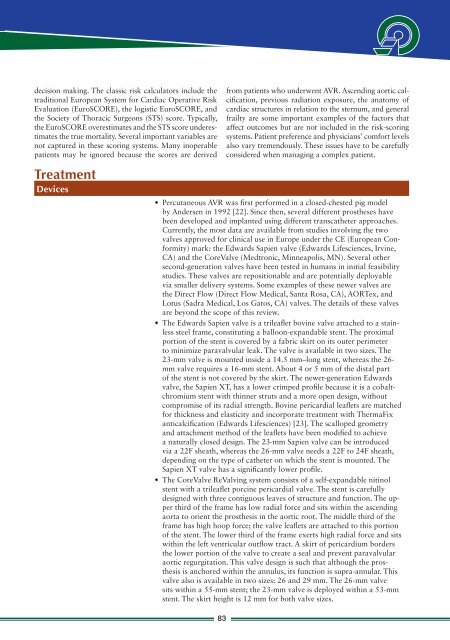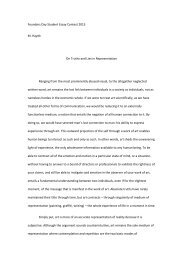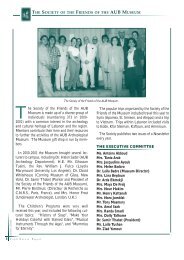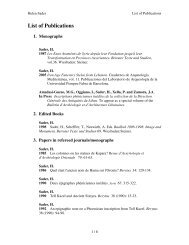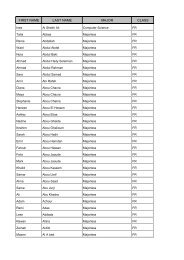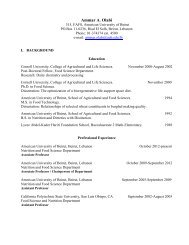The IX t h Makassed Medical Congress - American University of Beirut
The IX t h Makassed Medical Congress - American University of Beirut
The IX t h Makassed Medical Congress - American University of Beirut
Create successful ePaper yourself
Turn your PDF publications into a flip-book with our unique Google optimized e-Paper software.
468 Valvular, Myocardial, Pericardial, and Cardiopulmonary Disease<br />
decision making. <strong>The</strong> classic risk calculators include the<br />
traditional European System for Cardiac Operative Risk<br />
Evaluation (EuroSCORE), the logistic EuroSCORE, and<br />
the Society <strong>of</strong> Thoracic Surgeons (STS) score. Typically,<br />
the EuroSCORE overestimates and the STS score underestimates<br />
the true mortality. Several important variables are<br />
not captured in these scoring systems. Many inoperable<br />
patients may be ignored because the scores are derived<br />
Treatment<br />
Devices<br />
• Percutaneous AVR was fi rst performed in a closed-chested pig model<br />
by Andersen in 1992 [22]. Since then, several different prostheses have<br />
been developed and implanted using different transcatheter approaches.<br />
Currently, the most data are available from studies involving the two<br />
valves approved for clinical use in Europe under the CE (European Conformity)<br />
mark: the Edwards Sapien valve (Edwards Lifesciences, Irvine,<br />
CA) and the CoreValve (Medtronic, Minneapolis, MN). Several other<br />
second-generation valves have been tested in humans in initial feasibility<br />
studies. <strong>The</strong>se valves are repositionable and are potentially deployable<br />
via smaller delivery systems. Some examples <strong>of</strong> these newer valves are<br />
the Direct Flow (Direct Flow <strong>Medical</strong>, Santa Rosa, CA), AORTex, and<br />
Lotus (Sadra <strong>Medical</strong>, Los Gatos, CA) valves. <strong>The</strong> details <strong>of</strong> these valves<br />
are beyond the scope <strong>of</strong> this review.<br />
• <strong>The</strong> Edwards Sapien valve is a trileafl et bovine valve attached to a stainless<br />
steel frame, constituting a balloon-expandable stent. <strong>The</strong> proximal<br />
portion <strong>of</strong> the stent is covered by a fabric skirt on its outer perimeter<br />
to minimize paravalvular leak. <strong>The</strong> valve is available in two sizes. <strong>The</strong><br />
23-mm valve is mounted inside a 14.5 mm–long stent, whereas the 26mm<br />
valve requires a 16-mm stent. About 4 or 5 mm <strong>of</strong> the distal part<br />
<strong>of</strong> the stent is not covered by the skirt. <strong>The</strong> newer-generation Edwards<br />
valve, the Sapien XT, has a lower crimped pr<strong>of</strong>i le because it is a cobaltchromium<br />
stent with thinner struts and a more open design, without<br />
compromise <strong>of</strong> its radial strength. Bovine pericardial leafl ets are matched<br />
for thickness and elasticity and incorporate treatment with <strong>The</strong>rmaFix<br />
anticalcifi cation (Edwards Lifesciences) [23]. <strong>The</strong> scalloped geometry<br />
and attachment method <strong>of</strong> the leafl ets have been modifi ed to achieve<br />
a naturally closed design. <strong>The</strong> 23-mm Sapien valve can be introduced<br />
via a 22F sheath, whereas the 26-mm valve needs a 22F to 24F sheath,<br />
depending on the type <strong>of</strong> catheter on which the stent is mounted. <strong>The</strong><br />
Sapien XT valve has a signifi cantly lower pr<strong>of</strong>i le.<br />
• <strong>The</strong> CoreValve ReValving system consists <strong>of</strong> a self-expandable nitinol<br />
stent with a trileafl et porcine pericardial valve. <strong>The</strong> stent is carefully<br />
designed with three contiguous leaves <strong>of</strong> structure and function. <strong>The</strong> upper<br />
third <strong>of</strong> the frame has low radial force and sits within the ascending<br />
aorta to orient the prosthesis in the aortic root. <strong>The</strong> middle third <strong>of</strong> the<br />
frame has high hoop force; the valve leafl ets are attached to this portion<br />
<strong>of</strong> the stent. <strong>The</strong> lower third <strong>of</strong> the frame exerts high radial force and sits<br />
within the left ventricular outfl ow tract. A skirt <strong>of</strong> pericardium borders<br />
the lower portion <strong>of</strong> the valve to create a seal and prevent paravalvular<br />
aortic regurgitation. This valve design is such that although the prosthesis<br />
is anchored within the annulus, its function is supra-annular. This<br />
valve also is available in two sizes: 26 and 29 mm. <strong>The</strong> 26-mm valve<br />
sits within a 55-mm stent; the 23-mm valve is deployed within a 53-mm<br />
stent. <strong>The</strong> skirt height is 12 mm for both valve sizes.<br />
83<br />
from patients who underwent AVR. Ascending aortic calcifi<br />
cation, previous radiation exposure, the anatomy <strong>of</strong><br />
cardiac structures in relation to the sternum, and general<br />
frailty are some important examples <strong>of</strong> the factors that<br />
affect outcomes but are not included in the risk-scoring<br />
systems. Patient preference and physicians’ comfort levels<br />
also vary tremendously. <strong>The</strong>se issues have to be carefully<br />
considered when managing a complex patient.


